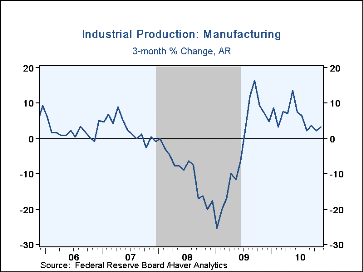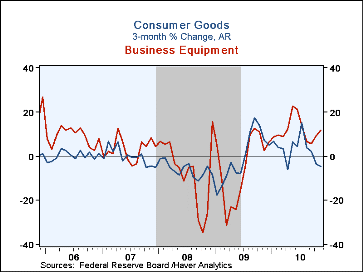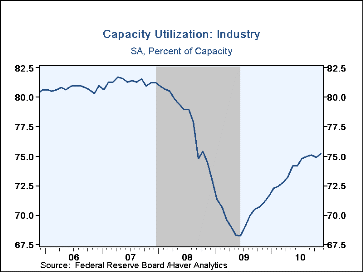 Global| Dec 15 2010
Global| Dec 15 2010U.S. Industrial Production Firms While Factory Sector Growth Is Stable
by:Tom Moeller
|in:Economy in Brief
Summary
U.S. industrial output growth recently has been hostage to variable weather influences. Growth in the factory alone, however, has been stable. For November, industrial production overall rose 0.4% and made up a 0.2% October decline, [...]
 U.S. industrial output growth recently has been hostage to variable weather
influences. Growth in the factory alone, however, has been stable. For November,
industrial production overall rose 0.4% and made up a 0.2% October decline,
initially reported as unchanged. The ups and downs of these figures are due to
first lower, then higher utility output. In the factory sector, growth was a
stable 0.3%, though the October figure was revised down from last month's
reading of 0.6%.
U.S. industrial output growth recently has been hostage to variable weather
influences. Growth in the factory alone, however, has been stable. For November,
industrial production overall rose 0.4% and made up a 0.2% October decline,
initially reported as unchanged. The ups and downs of these figures are due to
first lower, then higher utility output. In the factory sector, growth was a
stable 0.3%, though the October figure was revised down from last month's
reading of 0.6%.
The capital goods sector continued to lead last month's growth in overall industrial output with a 0.9% jump, though it was off modestly from the upwardly revised 1.4% October jump. On a three-month basis, output of business equipment grew at an 11.9% rate though that remained down from the 22.5% peak this past May. In the consumer sector, output slipped for the fourth consecutive month. Three-month growth fell to -4.5% as lower auto (-18.4%) and apparel (-2.9%) output offset gains in computers, video & audio equipment (10.6%) and appliances (2.2%). Amongst all industries, 57.4% realized higher output versus last month and 60.9% versus three months ago.
Capacity utilization overall improved to 75.2% with the rise in production and remained well above last year's low of 68.2%. A 75.0% November rate had been expected. The factory sector utilization rate, alone, ticked up to 72.8%. The increase here is from the low of 65.4% during the recession. But the figures continue to paint a picture of abundant unused productive capacity. The latest rates compare to roughly 80% just before the recession and a fifty year average also of 80%.
Of note is that declines in capacity started just after the recession ended. Overall capacity has fallen 0.2% during the last twelve months and, excluding high-tech industries, factory capacity is down 0.8%. Industrial production and capacity data are included in Haver's USECON database, with additional detail in the IP database.
| Industrial Production (SA, % Change) | Nov | Oct | Sept | Year Ago | 2009 | 2008 | 2007 |
|---|---|---|---|---|---|---|---|
| Total Output | 0.4 | -0.2 | 0.1 | 5.4 | -9.3 | -3.3 | 2.7 |
| Manufacturing | 0.3 | 0.3 | 0.1 | 5.4 | -11.1 | -4.5 | 2.9 |
| Consumer Goods | -0.5 | -0.2 | -0.4 | 2.3 | -5.8 | -4.2 | 0.9 |
| Business Equipment | 0.9 | 1.4 | 0.5 | 12.5 | -12.2 | -1.5 | 4.5 |
| Construction Supplies | 0.9 | 0.1 | -0.5 | 6.0 | -16.7 | -9.5 | -1.2 |
| Materials | 0.7 | -0.4 | 0.6 | 6.5 | -9.7 | -2.7 | 3.7 |
| Utilities | 2.0 | -3.7 | -1.3 | 2.5 | -2.6 | -0.1 | 3.4 |
| Capacity Utilization (%) | 75.2 | 74.9 | 75.1 | 71.1 | 70.0 | 77.9 | 81.3 |
| Manufacturing | 72.8 | 72.6 | 72.4 | 69.0 | 67.2 | 75.0 | 79.6 |
Tom Moeller
AuthorMore in Author Profile »Prior to joining Haver Analytics in 2000, Mr. Moeller worked as the Economist at Chancellor Capital Management from 1985 to 1999. There, he developed comprehensive economic forecasts and interpreted economic data for equity and fixed income portfolio managers. Also at Chancellor, Mr. Moeller worked as an equity analyst and was responsible for researching and rating companies in the economically sensitive automobile and housing industries for investment in Chancellor’s equity portfolio. Prior to joining Chancellor, Mr. Moeller was an Economist at Citibank from 1979 to 1984. He also analyzed pricing behavior in the metals industry for the Council on Wage and Price Stability in Washington, D.C. In 1999, Mr. Moeller received the award for most accurate forecast from the Forecasters' Club of New York. From 1990 to 1992 he was President of the New York Association for Business Economists. Mr. Moeller earned an M.B.A. in Finance from Fordham University, where he graduated in 1987. He holds a Bachelor of Arts in Economics from George Washington University.








